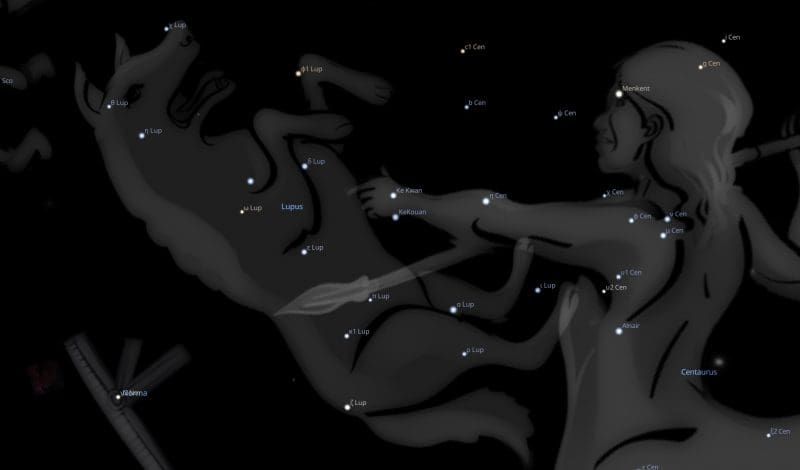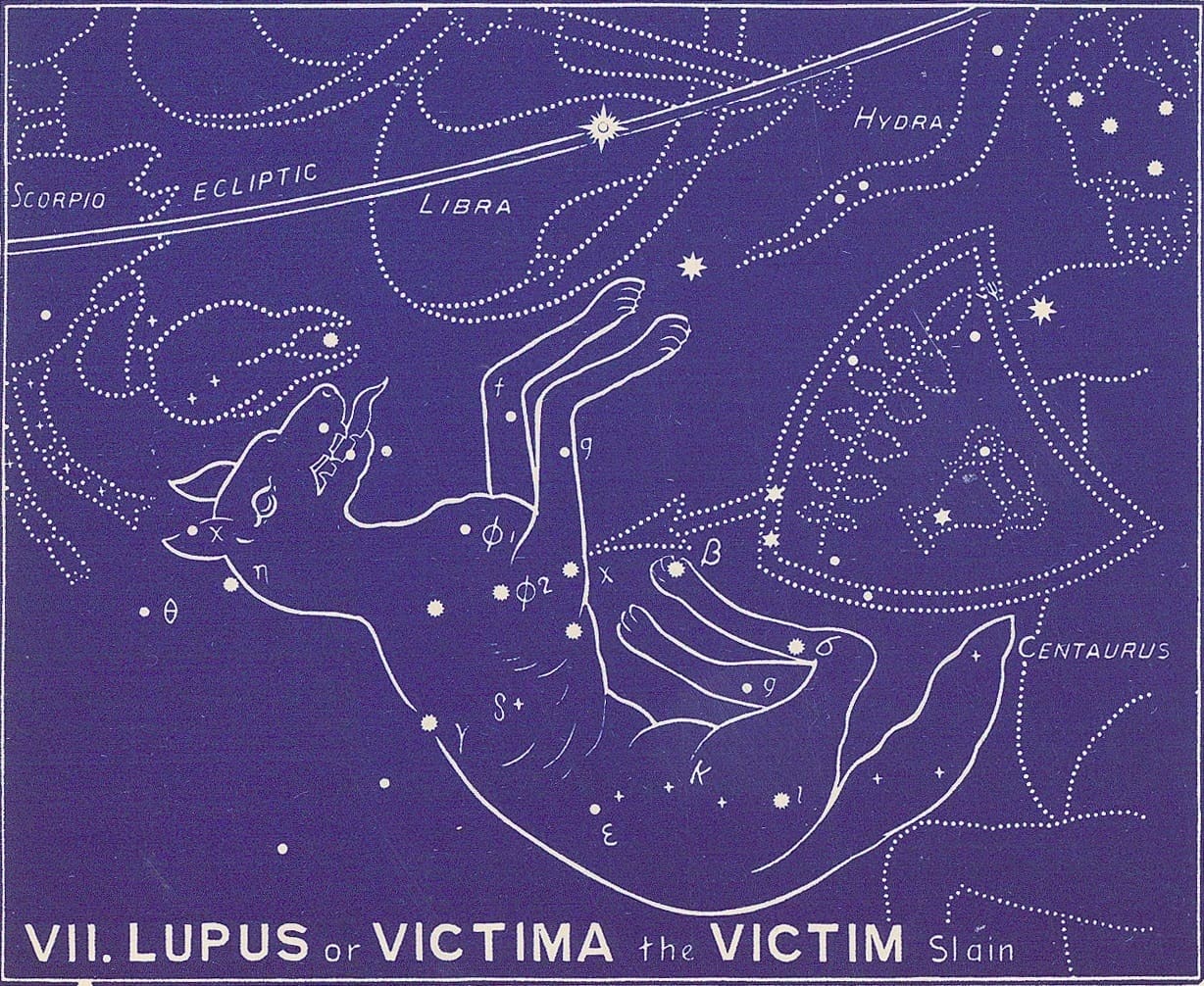FIXED STARS: Major Stars | 1000+ Stars | Constellations | About
Constellation Lupus the Wolf is a southern constellation bordering Libra, Centaurus, Circinus, Norma and Scorpius.Lupus is one of the 48 constellations listed by Ptolemy in the 2nd century and remains one of the 88 modern constellations. It spans 20 degrees of the zodiac in the Signs of Scorpio and Sagittarius.
Abbreviation: Lup
Genitive: Lupi
Lupus Constellation Stars
| 2000 | B | Star | Name | Sp. Class | Mag. | Orb |
|---|---|---|---|---|---|---|
| 18♏47 | 19♏29 | ι Lup | B2 | 3.55 | 1°40′ | |
| 23♏30 | 24♏12 | α Lup | Men | B1 | 2.30 | 2°10′ |
| 25♏01 | 25♏43 | β Lup | KeKouan | B2 | 2.68 | 2°00′ |
| 27♏29 | 28♏11 | φ1 Lup | Dùn Wán | K5 | 3.57 | 1°40′ |
| 27♏38 | 28♏20 | π Lup | B5 | 3.91 | 1°30′ | |
| 28♏39 | 29♏21 | δ Lup | Hilasmus | B1 | 3.22 | 1°50′ |
| 29♏28 | 00♐10 | κ1 Lup | Qizhenjiangjun | B9 | 3.88 | 1°30′ |
| 00♐07 | 00♐49 | ε Lup | B2 | 3.37 | 1°40′ | |
| 00♐45 | 01♐27 | ζ Lup | Chē Qí | G8 | 3.41 | 1°40′ |
| 01♐29 | 02♐12 | γ Lup | Thusia | B2 | 2.80 | 2°00′ |
| 02♐50 | 03♐32 | χ Lup | Chong Kwan | B9 | 3.97 | 1°30′ |
| 05♐46 | 06♐28 | η Lup | Tseih Choo | B2 | 3.42 | 1°40′ |
| 06♐44 | 07♐26 | θ Lup | Tseih Choo | B2 | 4.22 | 1°20′ |
α Lup has no official name, but it is known as Men, from the Chinese ChoYang Mun or Men (南門), meaning “the South Gate.” [1] However, the Chinese asterism 陽門 (Yáng Mén, Gate of Yang) is composed only of b Cen and c1 Cen. [2] On the Euphrates it probably was Kakkab Su‑gub Gud‑Elim, the “Star Left Hand of the Horned Bull,” said to have been a reference to the Centaur that was thus figured in that valley. [1]
β Lup is named KeKouan, meaning “a Cavalry Officer.” [1] It belongs to the Chinese asterism 騎官 (Qí Guān), meaning Imperial Guards. [2]
γ Lup is named Thusia, meaning “sacrifice,” short for Thusia Theriou, from the Greek θυσια θηριον, “sacrificial animal.” [3]
δ Lup is named Hilasmus (ιλασμος), which means “peace” in Greek. [4]
ζ Lup is named Chē Qí. It is the first star in the Chinese asterism 車騎 (Chē Qí), meaning “Chariots and Cavalry.” [2]
η Lup and θ Lup Lup share the traditional Chinese name Tseih Choo. Together, they make up the Chinese asterism 積卒 (Jī Zú), meaning “Group of Soldiers.” [2]
κ1 Lup is named Qizhenjiangjun. κ1 Lup and κ2 Lup are 騎陣將軍 (Qí Zhèn Jiāng Jūn), meaning “Chariot and Cavalry General.” [2]
φ1 Lup has the traditional Chinese name 頓頑 (Dùn Wán), meaning “Trials.” [2]
χ Lup is named Chong Kwan. ψ2 Lup and χ Lup make up the Chinese asterism 從官 (Cóng Guān), meaning “Retinue.” [2]
Lupus Astrology
Robson
Legend. The wolf is said to be placed in the heavens as a reminder of the religious nature of Chiron the Centaur, who is depicted as spearing it in order to offer it as a sacrifice.
Influence. According to Ptolemy the bright stars are like Saturn and partly like Mars. Lupus is said to give an acquisitive, grasping, aggressive, prudent and treacherous nature, with a keen desire for knowledge, and strong ill-regulated passions. [5]
Allen
Lupus, the Wolf, an idea for the figure said to be from the astrologers’ erroneous translation of Al Fahd, the Arabian title for this constellation, their Leopard, or Panther. The Greeks and the Romans did not specially designate these stars, and thought of them merely as a Wild Animal, the Θηρίον of Aratos, Hipparchos, and Ptolemy; the Bestia of Vitruvius; Fera of Germanicus; Quadrupes vasta of Cicero; Hostia, the Victim, of Hyginus; Hostiola, cited by Bayer; Bestia Centauri, by Riccioli; and Victima Centauri.
The Wolf reappeared as Lupus in the Alfonsine Tables, and as Fera Lupus in the Latin Almagests, while Grotius said that Panthera was Capella’s name for it.
Bayer also had Equus masculus and Leaena; and La Lande, Leo Marinus, Deferens leonem, Canis ululans, Leopardus, Lupa, Martius, — wolf being sacred to Mars, — and Lycisca, the Hybrid of the wolf. Belua, the Monster, is found in early works.
The Arabians also called it Al Asadah, the Lioness, and Al Sabuʽ, the Wild Beast. But the Desert astronomers seem to have mixed some of its smaller stars with a part of the Centaur as Al Shamārīḣ, the Palm Branches, and Ḳaḍb al Karm, the Vine Branch.
Zibu, the Beast, of Euphratean cylinders, may be for this constellation; and Urbat, the Beast of Death, or the Star of the Dead Fathers, is a title for it attributed to the Akkadians.
Aratos wrote of it, “another creature very firmly clutched,” and “the Wild-beast which the Centaur’s right hand holds” as an offering to the gods upon the Altar, and so virtually a part of the Centaur; but Eratosthenes described it as a Wine-skin from which the Centaur was about to pour a libation; while others imagined both the Beast and the Wine-skin in the Centaur’s grasp. Mythologists thought it the animal into which Lycaon was changed.
Although very ancient, Lupus is inconspicuous, lying partly in the Milky Way, south of Libra and Scorpio, east of the Centaur, with no star larger than 2.6 magnitude. Gould enumerates 159 naked-eye stars, among which is an unusual proportion of doubles. [2]
Bullinger
Its modern name is Lupus (a wolf) because it looks like one. It may be any animal. The great point of this ancient constellation is that the animal has been slain, and is in the act of falling down dead. Its Greek name is Thera, a beast, and Lycos, a wolf. Its Latin name is Victima, or Bestia (Vulg. Gen 8:17), which sufficiently indicates the great lesson. This is confirmed by its ancient Hebrew name, Asedah, and Arabic Asedaton, which both mean to be slain.
More than 22 of its stars have been cataloged. None of them are higher than the 4th magnitude; most of them are of the 5th or 6th… In the ancient Zodiac of Denderah, He is pictured as a little child with its finger on its lips, and He is called Sura, a lamb! In other pictures, He has, besides, the horn of a goat on one side of His head. All this pointed to one and the same great fact, viz., the development and explanation of what was meant by the bruising of His heel! [6]
References
- Star Names, Their Lore and Meaning, Richard Hinckley Allen, 1889, p.278-279.
- List of Chinese Star Names – Wikipedia
- Gamma Lupi – Wikipedia
- Delta Lupi – Wikipedia
- Fixed Stars and Constellations in Astrology, Vivian E. Robson, 1923, p.50.
- The Witness of the Stars, E. W. Bullinger, 1893, Lupus (Victima the Victim Slain)


